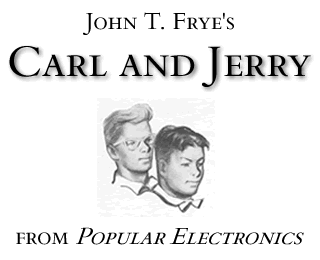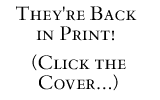|
I discovered electronics in 1963, when I was eleven,
by digging around in the stuff people put out on the curb on
garbage day, and dragging home dead radios and TVs for avid
dissection in the garage. And for years I pieced together radios
out of chassis pickins' and Fahenstock clips, guided by books like
Harry Zarchy's Using Electronics and Alfred Morgan's The
Boy's Second Book of Radio and Electronics. My best friend
Art, who lived across the alley, got into electronics a year or so
later, but he had something even better: Stacks and stacks of old
Popular Electronics magazines, given to him by his Uncle
George, who was an electrical engineer for the phone company. We
both prowled through them incessantly, looking for cool projects
to build.
We saw lots of cool projects. And before too long, we saw
ourselves there as well.
Every issue in the pile had a short fiction story in it about two
boys named Carl and Jerry, who were as obsessed with electronics
as we were, and used it to help other people, foil criminals,
impress girls, and get out of jams. The boys were a little older
than Art and I, but beyond that, the resemblances were striking:
One was thin, one chunky. One had glasses, one did not. One was
good with theory (as Art was) the other was better with tools
(me.) Every story described a concept in electronics, and most of
the time put it to work.
To Explain and Inspire
I didn't know it at the time, but Carl and Jerry had been in Popular
Electronics since the magazine's debut issue in October,
1954. John T. Frye wrote an episode almost every month for ten
years—119 stories!—until November 1964. The stories, while often
fiendishly clever, were sometimes a shade breathless but also a
little wry in a way that appealed to slightly precocious
twelve-year-old boys. They reminded me of the Tom Swift, Jr. books
that I was also reading at about that time, only with real,
basement-friendly technology instead of Swiftian half-magic
super-science. (See
my essay on Tom Swift for more about this.) As I discovered
much later, there was actually greater resemblance to the older
and more down-to-Earth Tom Swift Sr. books, like Tom
Swift and His House on Wheels. (Egad! Tom Swift
invented the RV!) As John Frye was most likely twelve years old
toward the end of the Tom Swift, Sr. era, this isn't surprising.
The language was amazingly similar, right down to the ubiquitous
said-book-isms:
"Ok, let's get on with
it," Carl prodded.
"Holy cow!" Jerry
breathed. "That was a tornado!"
The characters in the stories murmured, demanded, howled,
insisted, commanded, drawled, scoffed, and did almost everything
but "said." But talking about flaws in the fictional techniques
misses the whole point: The stories were there to explain things,
and to inspire us to emulate Carl and Jerry's curiosity and
ingenuity by working with electronics ourselves.
As with the Tom Swift books, each story revolved around a science
or technology concept. Occasionally the entire story was a dialog
between the boys, one asking questions and the other lecturing.
("TV Antennas" from August 1955, and "The Bell Bull Session" in
December 1961 are good examples.) But more often than not, the
boys build an interesting gadget, explaining along the way how it
worked, and then put it to use in a clever fashion. Perhaps the
crispest example is "Lie Detector Tells All" in November 1955. The
boys build a lie detector (explaining the principles behind it)
and test it on Jerry's parents. Mr. and Mrs. Bishop are both
caught up in "little white lies" in front of one another, and then
each quietly approaches the boys later on and offers them ten
dollars to dismantle the machine!
The stories span the whole universe of what hobby electronics was
about at the time: Ham radio, sonar, metal detectors, Hi-fi audio,
tape recorders, remote sensors, radio controlled models, and so
on. Nor did Frye cling to the past: When the world's first
transistor radio appeared in 1955, Carl and Jerry had one almost
immediately, and used it to track a tornado. ("Tornado Hunting by
Radio", May 1955.)
Frye cited experts in the real world, occasionally with
references to science and technology journals. He made semiregular
mention of projects and articles that had recently appeared in Popular
Electronics, often as the major basis for the story at hand.
In the February 1961 issue, for example, he made good use of the
cover-story gizmo: the Infraphone, a sort of walkie-talkie that
encoded voice on a beam of infrared light. Working with police,
they used a pair of Infraphones to foil a gang of thieves who were
monitoring police radio frequencies and thus eluding capture.
The Carl and Jerry stories have been criticized for being a
little too glib, and making electronics sound easy. One thing that
not everyone remembers is that the boys occasionally taught us
that not all projects work out. In "The Meller Smeller," (January
1957) the boys attempt to use an electrostatic filter to remove
odors from the air. They basically attempt an electronic gas mask,
and then have the bad karma to test it for the first time on a
skunk. It didn't work. They buried their clothes in the backyard.
Not all of the stories are "adventures" in any sense of word. As
I mentioned above, many are simple dialogs between the boys, as
they build or troubleshoot some sort of device. This may have been
necessary at times. 2,500 words is not a lot of room to
move! In "Tussle with a Tachometer" (July, 1960) they build a tach
for their car, from scratch, and explain how it works and how to
calibrate it. There's no adventure, but once you read it you'll
have a very clear sense for how automotive tachometers of that era
functioned. The adventure came in a couple of issues later, in
"Tick-Tach-Dough" (September 1960). The boys attach a tape
recorder to their homebrew tach to test its calibration. Their car
is stolen by bank robbers, who stash what they took from a bank
somewhere and won't say where. Carl and Jerry play detective, and
use stereo headphones to play the tach recording into one ear
while listening to the real tach in the other, to retrace the
vehicle's speed and acceleration in order to find the stolen cash.
Brilliant—but incomprehensible if you don't know how tachometers
work. Clearly, Frye had to tell the first story (how tachs work)
to be able to use a hacked tachometer to solve a crime in a later
story.
Could They Really Do That?
Something that Art and I often wondered is whether the technology
tricks Frye built his stories around were feasible. We often asked
one another: Would that really work? Many of them were no
great challenge, especially in the first few years of the series.
Using a solenoid-triggered camera to catch a henhouse thief (as
the boys did in June, 1956) almost seemed too easy to us. Later
on, as Frye hit his stride, the stories became cleverer, and the
technology a lot subtler. Strapping a theremin to your back to
provide a kind of audio biofeedback as you practice basketball
free-throws ("Therry and the Pirates," April, 1961) would be
breathtakingly brilliant—if it worked. Alas, we had no way to know
short of building a theremin ourselves and trying it.
Another brilliant invention was Jerry's "infrasonic" microphone
in "A Low Blow," March, 1961. The device resembled an aneroid
barometer, consisting of a thin sheet of spring brass glued over
the open end of a mayonnaise jar. The capacitance between the
brass sheet and a steel plate inside the jar changed as variations
in air pressure (as by extremely low frequency sound waves) flexed
the brass sheet, and the changing capacitance pulled the frequency
of an audio oscillator. Placed at the end of a long run of
about-to-be-buried natural gas pipes out in the street (for noise
reduction) the device reported the subsonic emanations of a small
tornado in the moments before the tornado scattered the pipe
sections and destroyed the infrasonic mic. That story made me
absolutely crazy to build one, but I wasn't quite sure
where to begin. I was only 12, just beginning to understand
electronics, and too poor to afford the sort of test gear that
Carl and Jerry took for granted. But I never doubted for a
millisecond that the device would work, and I ached to be good
enough at the craft to build things like that.
Even at its wildest, Carl and Jerry's technology remained just
this side of outrageous, and while a degreed electrical engineer
might quibble with the gadgetry, Art and I were still 12-year-old
newbies who had no clue. What did occasionally make us roll our
eyes were the preposterous situations that Carl and Jerry found
themselves in, and the remarkable coincidences that allowed them
to prevail, especially when they got into trouble. Once, when they
were trapped by a load of coal dumped into the high school coal
bin, ("A Nickel's Worth," March 1958) they signaled for help by
tapping into the school PA system through a cable running through
the rafters in the little room they were stuck in—using a
transistor audio oscillator that Carl just happened to
have in his pocket, powered by a cell made of coins and paper
moistened with spit.
This Oh Come On factor was a little strong at times, as
was the Haven't We Heard This One Before? factor. Getting stuck
somewhere and signaling for help in peculiar ways (always using
Morse Code) became a Carl and Jerry standard. Making a spark
transmitter from a broken model airplane—kewl! Doing the same
thing with an outboard motor, well, sure. Escaping from underneath
an overturned car by making a spark transmitter out of the
ignition coil, OK. Using Morse Code smoke signals to escape from
murderous bootleggers...c'mon awready. Been there! Done that!
Sure, we rolled our eyes—but we kept watching the mailbox for the
next issue, just the same. And with the perspective of forty years
of hindsight (and having read about 100 of the stories within the
past two weeks) I have to admire the way that John Frye covered
virtually the entire universe of hobby electronics of his day,
which was much narrower than ours is now. Small wonder he
repeated himself a little—and I grin a little to wonder what he
would be able to do if he were alive and writing today!
Evolving Characters
Like any good fictional series, especially one targeted at young
people, the Carl and Jerry canon contains a cast of accessible
characters and uses them quite consistently over the years. In
addition to Carl and Jerry themselves, we meet:
- Bosco, Carl's dog (said to be an airdale but mostly looking
and acting like a mutt);
- Eight-To-Go, a black cat that the boys barely rescue from an
oil drum sunk to the bottom of a flooded quarry, hence his
name—one of nine lives down, eight to go...
- Police Chief Morton, who is both exasperated with the boys'
exploits and dependent on them to solve crimes;
- Mr. Gruber, an elderly man down the street who rode with Teddy
Roosevelt's Rough Riders but is obsessed with flying saucers and
science fiction;
- Norma, a girl living next door who (at 22 or 23) is a little
too old to be a romantic interest to the boys but who looks to
them to help her with her love life;
- Mr. Stagg, the clueless high-school principal;
- Jodi Preston, a coed and ham radio op studying EE with the
boys at Parvoo University; and
- Thelma, a friend of Jodi's at Parvoo, about whom we don't in
truth learn much, but who may exist to keep the boys from
fighting over Jodi!
Most of the stories take place in and around Carl and Jerry's
small-town home in northern Indiana, though with geological
features like caves and hills that one just doesn't associate with
Midwestern corn country.
Unlike Tom Swift and most of the characters in the Sunday comics,
Carl and Jerry grew up over the years. The very first stories make
them sound quite young, perhaps thirteen or at most fourteen. By
May 1959, the story states that the boys are 16. They got around
entirely on their bikes until their respective fathers agreed to
allow them to share a car in the June 1960 story, "Two Tough
Customers," which may have less electronics in it than any other
story in the series. (It does explain how to buy a used car
sensibly.) They finally graduate from high school in June, 1961.
In "Off to a Bad Start" (September 1961) the boys arrive at
Parvoo University (a thinly veiled reference to Purdue) and bemoan
the fact that they don't have their electronics lab with them.
They try to decide whether they can improvise an intercom for a
prank (which almost gets them in serious trouble) and while they
can round up parts by dumpster diving, doing the assembly is a
problem. But no: Carl remains very true to himself, and pulls a
tiny pencil solding iron and some solder from his travel case,
saying:
"You may get old Carl
away from home without his wallet, his toothbrush, or even his
pants, but you're not going to get him away without some kind
of soldering iron," he boasted.
It's intersting to watch Carl and Jerry's attitude toward girls
evolve over the years. In early stories, they sound more like
fifth graders who consider girls to have cooties, and squirm when
Norma kisses each on the cheek to thank them for saving her from
an eccentric suitor. Their relationship with Norma is intriguing
all by itself. It begins with helpful politeness (see "Ultrasonic
Romance", July 1955) but by the late 50s there is an undercurrent
of sexual tension among the three that made me grin. This scene
(from "Parfum Electronique", July 1958) is funny enough to
reproduce whole:
"I think the girl
needs a little gentle persuasion," Jerry said quietly to Carl
as they both rose to their feet.
"Right!" Carl
exclaimed as he grabbed both sides of the hammock and brought
them together over the top of Norma. He held them in place in
spite of Norma's shrieks, struggles, and threats, until Jerry
fastened them together with two huge horse-blanket pins that
had been clipped around the hammock ropes. Then the boys stood
at each end of the hammock and tugged alternately at the ropes
to bounce and toss the pinned-in girl wildly about.
"Stop! Stop!" she
finally gasped. I'll do it! And if you've messed up my
permanent, I'm going to kill you both."
"Ah, Norma," Carl
said, unfastening the pins and grinning down at the tousled
but very pretty girl; "from now on you will always be our
favorite pin-up!"
Genuine stirrings of affection for the other sex begin to show up
in late 1958, even if the boys sometimes strive mightily to deny
them. In "Vox Elektronik" (September 1958) Carl takes up
ventriloquism because a girl named Linda seems to appreciate it
when performed by a local boy named George. When it becomes clear
that he has no talent for it, Carl gets the idea that they could
put a little radio receiver into his dummy Splinter, and even rig
solenoids to work the dummy's jaw in response to the received
sound. Jerry sees through Carl's motives, however, and is dubious:
“Frankly, Carl, I
take a dim view of the whole business. I thought we both felt
the same way about girls: There will be plenty of time for
them later, but right now you and I can have lots more fun
with electronics.”
“I know,” Carl said
miserably; “but I still can’t stand being made to look like a
dope in front of Linda—at least not by a porch-swing poodle
like George."
The real lesson comes later: After Splinter cons Linda and George
completely, Linda responds a little too enthusiastically, and
Carl, now tormented by conscience as well as concern that a girl
was becoming stuck on him, explains to them what he's done and
slinks home again.
Frye has some further fun with Carl and girls in the December
1958 story "Under the Misteltoe." The boys are invited to a teen
Christmas party, but they know that a local hussy plans to steer
Carl under the misteltoe and demand a kiss. The boys concoct a
plan to deliver a slight shock to Cindy from a 130V battery and a
current-limiting resistor at kiss-time, and thus dampen her ardor.
Unfortunately, Jerry's geek-girl cousin Pat overhears the plot and
hatches a counterplot: Rigging Cindy with an identical 130V
battery with the polarity turned the other way! (The two batteries
buck and thus no current flows.) Expecting to shock Cindy with a
quick kiss, Carl finds that nothing happens. Assuming a loose
wire, he prolongs the kiss while trying to reconnect the wire, and
ends up the red-faced victim of catcalls and wolf-whistles from
the other partygoers, basically getting the opposite effect from
what he intended.
Electronics-savvy Cousin Pat prefigures a new character who
appears soon after the boys go off to Parvoo: Jodi Preston, a
southern belle in Parvoo's EE program with a drawl and a ham
license. The boys use their wizardry to help Jodi much as they
helped Norma, but this time Carl and Jerry have no excuses;
they're college boys and old enough to go out on dates. Frye
introduces a second girl, Jodi's friend Thelma, but says little
about her, and one gets the sense that she's there to balance the
slate. By November 1963 Carl, Jerry, Jodi, and Thelma were a
foursome, but there just isn't the goofy warmth among them that
John Frye created between the boys and Norma.
As little as we actually know about John T. Frye himself, it's
possible to find little glimpses of the man here and there in how
his characters act and what they say. Frye certainly made his
feelings known about liberal arts types at the end of "Wrecked By
a Wagon Train" (February, 1962) when the boys help nab a student
from "a liberal arts university" in the southern part of Indiana
who was robbing fraternities at Parvoo. Jerry says:
"You know,
electronics was a nemesis for that poor guy. Electronics put
the finger on him in the first place, and then a TV wagon
train wrecked his alibi. His second mistake was
transferring his operations from a liberal arts university to
one with a strong accent on electronics."
"Well, you wouldn't
expect a guy dumb enough to make the first mistake of starting
to steal to be very bright," Carl muttered sleepily.
Maybe it was just the university. (Indiana State?) In "Substitute
Sandman" (November, 1961) Carl tells us:
"Our English teacher
says that education is the process by which a person moves
from cocksure ignorance to thoughtful uncertainty. Some folks
are hard to move."
Heh!
Evolving Art
As effective as John Frye's stories were, they might not have
grabbed their intended audience quite so viscerally if the
magazine's artists had not gotten the boys' physical appearance
down almost exactly right. There were illustrations
associated with every single story, and over the years, the
picture of tall, lean Carl beside shorter, stockier Jerry was
burned into the mythic memory of their loyal fans.
It didn't happen immediately...but close, close. When PE's staff
artists first drew the boys in the magazine's debut issue, Jerry
came off as a lazy-looking, unlikeable little brat, with a face
that did not suggest the high intelligence that Frye had given
him.
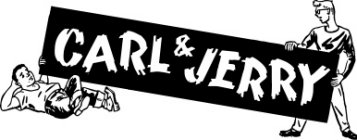
Carl, on the other hand, became more realistic over time but did
not change substantially until the very last year of the series.
The "Far Side" glasses (which were mainstream back then—my wife
wore them in the early Sixties and thought they were cool!) and
blonde pompadour remained with Carl until late 1963. It didn't
help that the early issue illos were drawn mostly as cartoon
archetypes. It was too easy to present Jerry as the iconic "little
fat boy."
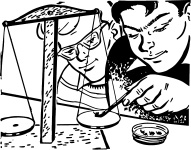 PE
quickly realized its mistake, and gave Jerry a radical makeover
with the April 1955 issue. (Perhaps PE got a few too many letters
of complaint from "little fat boys.") Jerry remained shorter and
fatter than Carl, but he was at least a little more buff and now
had an intelligent and likeable face, looking much more like a
teenage slide rule jockey and less like a juvenile delinquent with
an IQ of 77. The boys were now drawn older as well, moving from
early teens to senior high. PE
quickly realized its mistake, and gave Jerry a radical makeover
with the April 1955 issue. (Perhaps PE got a few too many letters
of complaint from "little fat boys.") Jerry remained shorter and
fatter than Carl, but he was at least a little more buff and now
had an intelligent and likeable face, looking much more like a
teenage slide rule jockey and less like a juvenile delinquent with
an IQ of 77. The boys were now drawn older as well, moving from
early teens to senior high.
I find it interesting that the redesigned Jerry looks a great
deal like a teen-aged version of the adult John T. Frye, as shown
in a 1951 photo published in
the Logansport newspaper in 1951 and later in 1962.
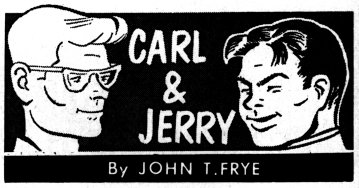
The quality of the art for the series was always a little uneven.
As a former magazine editor, I can guess why: The staff artists
may not have been given their assignments until the issue had been
laid out, and the editors knew how much space remained for art
after the articles and ads were "in flats." (They may also have
been technical artists with more experience in schematics than
cartooning.) There was almost always at least one drawing, but
there were sometimes as many as four, and the drawings varied
widely in size and (sometimes) shape. Knowing the tight schedule
of a monthly magazine, it's not impossible that the artists had as
little as an hour or two to knock out a story's illos. It may be
that the clumsiest drawings were last-minute demands: "McGuffin
Radio just canceled their ad, so we have another three
column-inches to fill in Carl and Jerry. You've got half an hour.
Get cracking!"
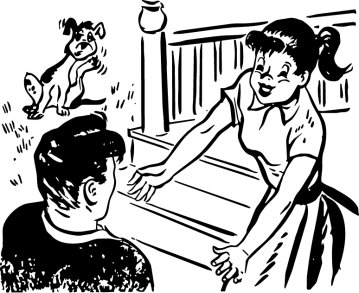
This July, 1955 depiction of Bosco and girl-next-door Norma may
count as the worst illo of the series. I wonder if it was one of
those quarter-to-midnight emergency jobs, dashed off in ten
minutes by an exhausted art staffer who just wanted to go home.
In May of 1959, the boys got a design tweak, which coincided with
the magazine itself moving from a rougher newsprint to a smoother,
coated paper. The smoother paper allowed the use of finer halftone
screens and a much more nuanced art style. Carl and Jerry went
into slightly softer focus but became a lot more realistic, and
the story-header image below (which was used for almost three
years) is how most people remember them today. The new Jerry,
while still slightly rounder than Carl, could no longer even
remotely be considered "fat." (Every so often an artist drew Jerry
with an anomalous tummy—except for the boys' faces, art design
consistency among the stories was spotty.)
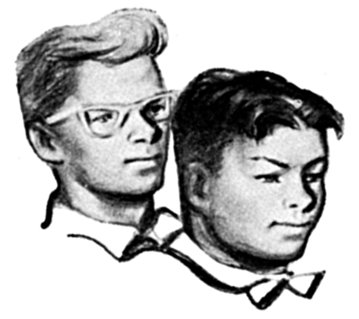
The boys got one last art makeover in the November, 1963 issue,
by an artist who had clearly cut his teeth on fashion catalogs, or
maybe cigarette ads:
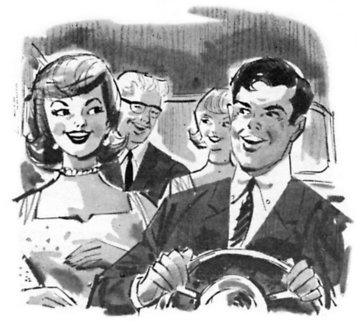
The magazine dropped the standard story header entirely, and the
art treatment changed with almost every issue. Toward the end of
1964, the single opening illustration was generally the only
illustration there was, when in earlier years there were as many
as five. The boys were now a pair of fully adult Sunday sales
insert mannikins, with neither charm nor any suggestion of the
teenage geekiness that elevated them to hero status among boys who
had looked "just like them."
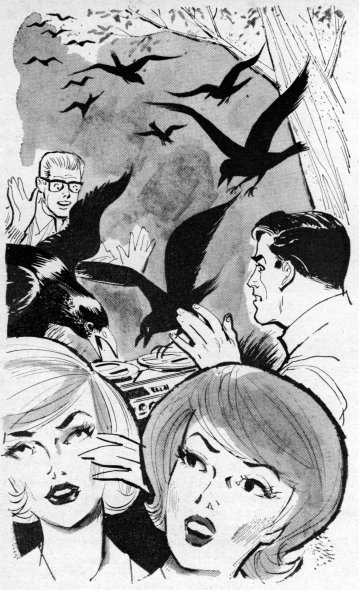
(Does anybody else find the depictions of Jodi and Thelma in the
foreground here just a little bit creepy?)
This final artwork faux pas didn't matter much; by then
those of us who loved the boys knew precisely what they looked
like. It was the artist who had it wrong. They looked like us,
and had for nine years. Nothing ever would (nor ever could) change
that!
Did It Work?
In creating Carl and Jerry, John T. Frye drew on an ancient and
now mostly lost literary form: didactic (tutorial) fiction. How
well he drew characters and situations is less important than
whether we remember the lessons, forty-odd years later. I know
that I do. Having read "The Lightning Bug" (November, 1963) I
pulled the March 1962 issue from Art's stacks and built "Emily,
the Robot with the One-Track Mind" and won First Prize at our
eighth grade science fair. The Emily article explained how it
worked, but I already knew the general principles, courtesy Carl
and Jerry.
A fair number of people my age and older have written to me over
the years, generally in response to my own tutorial books like Complete
Turbo Pascal and The Delphi Programming Explorer,
and when we spoke of Carl and Jerry, many indicated that it was
the boys who had pushed them "over the edge" into careers in
science and technology. One gentleman, a now-retired EE, said
this: "They made it sound maybe a little too easy, but that just
made me work harder so I could succeed like they did. It worked."
Boy, did it ever.
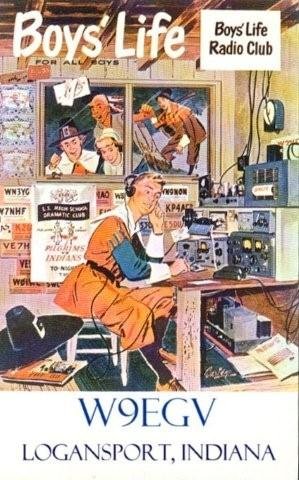
(John Frye's QSL card, courtesy Bob Ballantine
W8SU.)
|
|
|
|
| A
New Company Is Launched |
|
Carl meets Jerry, who
solves a ham radio antenna problem for him.
|
| October 1954: V1 #1 |
| A
Light Subject |
|
The boys discuss
photoelectricity and Jerry demonstrates a photocell.
|
| November 1954: V1
#2 |
| The
Hot Dog Case |
|
Carl's dog comes home
with radioactive paws, and the boys track him by radio.
|
| December 1954: V1
#3 |
| Operation
Startled Starling |
|
The boys tape record a
bird's distress cry to scare away some starlings.
|
| January 1955: V2 #1 |
| Two
Detectors |
|
The boys use 2M HTs to
eavesdrop on what they think is a murder.
|
| February 1955: V2
#2 |
| Going
Up, Up, Up |
|
Will TV signals bounce
off a silver-painted balloon? Maybe...
|
| March 1955: V2 #3 |
| The
Attraction of Ham Radio* |
|
Carl talks about ham
radio to Jerry, in preparation for a school speech.
|
| April 1955: V2 #4 |
| Tornado
Hunting by Radio* |
|
The boys use a
directional TV antenna to track a storm, and spot a
tornado.
|
| May 1955: V2 #5 |
| How
TV Works* |
|
Using a garden hose and
the garage wall, Jerry explains how TV works.
|
| June 1955: V2 #6 |
| Ultrasonic
Romance* |
|
Jerry devises an
ultrasonic mosquito killer to help the girl next door.
|
| July 1955: V3 #1 |
| TV
Antennas* |
|
On a hike, Jerry explains
how different kinds of TV antennas work.
|
| August 1955: V3 #2 |
| Electric
Shock* |
|
Jerry gets a bad shock
from a faulty radio, and explains the dangers of 117V.
|
| September 1955: V3
#3 |
| The
Great Bank Robbery |
|
Clever use of a 2M
transceiver foils a bank robbery.
|
| October 1955: V3 #4 |
| Lie
Detector Tells All |
|
Jerry subjects his
parents to his home-made lie detector.
|
| November 1955: V3
#5 |
| Santa's
Little Helpers |
|
The boys build a talking
Santa figure for the front lawn to amuse local kids.
|
| December 1955: V3
#6 |
| Trapped
in a Chimney |
|
The boys create a spark
transmitter to escape from an old smokestack.
|
| January
1956: V4 #1 |
| How
to Haunt a House |
|
A man hires Carl &
Jerry to "haunt" a house he owns with gadgetry.
|
| February 1956: V4
#2 |
| Electronic
Trap |
|
Jerry's proximity relay
alerts him to a burglar in the basement.
|
| March 1956: V4 #3 |
| Gold
Is Where You Find It |
|
The boys find an old
farmer's gold watch with a metal detector.
|
| April 1956: V4 #4 |
| Feedback |
|
Jerry teaches Carl about
negative feedback while listening to birds.
|
| May 1956: V4 #5 |
| Geniuses
at Work |
|
The boys rig a camera in
a henhouse to catch an intruder on film.
|
| June 1956: V4 #6 |
| Anchors
Aweigh |
|
Jerry's radio-controlled
tugboat rescues a man from a boating accident.
|
| July 1956: V5 #1 |
| Bosco
Has His Day |
|
Carl's dog Bosco learns
to retrieve with some help from a tiny radio receiver.
|
| August 1956: V5 #2 |
| Electronic
Beach Buggy |
|
An RC wagon carrying
Jerry's metal detector foils a counterfeiting ring.
|
| September 1956: V5
#3 |
| Abetting
or Not? |
|
The boys' 2.4 GHz radio
interferes with the local police radar speed trap.
|
| October
1956 V5 #4 |
| Eeeelectricity! |
|
Jerry explains to Carl
how electric eels generate electricity.
|
| November 1956: V5
#5 |
| Extra-Sensory
Perception |
|
The boys build a covert
radio transceiver and fake psychic powers.
|
| December 1956: V5
#6 |
| The
"Meller Smeller" |
|
An attempt to remove
odors with high voltage fails spectacularly.
|
| January 1957: V6 #1 |
| Electronic
Cops and Robbers |
|
The boys bust a car-theft
ring with radio direction-finding gear.
|
| February
1957: V6 #2 |
| The
Secret of Round Island |
|
A radio-triggered camera
on a kite reveals a bootlegging operation.
|
| March 1957: V6 #3 |
| Strange
Voices |
|
A neighbor's wireless
headphones bleed into the boys' VLF loop antenna.
|
| April 1957: V6 #4 |
| "Holes"
to the Rescue |
|
A transistorized SW
converter allows the boys to call for help on 10M.
|
| May 1957: V6 #5 |
| Out
of the Depths |
|
While recording fish
sounds in an old quarry, the boys rescue a cat.
|
| June 1957: V6 #6 |
| Brain
Waves |
|
Jerry tries to read
Carl's brain waves, and reads the wall clock instead.
|
| July 1957: V7 #1 |
| A
Crusoe Caper |
|
Lost in a storm, the boys
call SOS using the magneto of an outboard motor.
|
| August 1957: V7 #2 |
| Electronic
Shadow |
|
C&J's homebrew
radio-equipped gyrocompass foils a bank robber.
|
| September 1957: V7
#3 |
| The
Cat Gets a Treatment |
|
The boys use a CB
transmitter as a diathermy machine to help their cat.
|
| October 1957: V7 #4 |
| The
Demonstration |
|
The boys "enhance" a
Wimhurst machine with a hidden Tesla coil.
|
| November 1957: V7
#5 |
| Santa
Knows All |
|
Carl and Jerry rig a
hidden transmitter for a department-store Santa.
|
| December 1957: V7
#6 |
| Cupid
and the Ions |
|
A mood-boosting ion
generator makes Norma's boyfriend's hair stand on end.
|
| January 1958: V8 #1 |
| Electronic
Detective |
|
The boys plant a
miniature transmitter in a cap gun to nab a young
shoplifter.
|
| February 1958: V8
#2 |
| A
Nickel's Worth |
|
A coin cell allows the
boys to signal for help when they're trapped in a coal
bin.
|
| March 1958: V8 #3 |
| Little
Drops of Water |
|
A moisture sensor, a
window closer, and a water pistol nab a second-story
man.
|
| April 1958: V8 #4 |
| Fish-Sniffing |
|
A fish with an ultrasonic
tag helps the boys find a school of bluegills.
|
| May 1958: V8 #5 |
| The
Tele-Tattletail |
|
Jerry's lashup telemetry
system keeps two small boys from learning to smoke.
|
| June 1958: V8 #6 |
| Parfum
Electronique |
|
An electronic odor
generator drives off yet another of Norma's boyfriends.
|
| July 1958: V9 #1 |
| Cow-Cow
Boogie |
|
A radio-equipped,
booze-loving cow helps nab a gang of bootleggers.
|
| August 1958: V9 #2 |
| Vox
Elektronique |
|
Carl overly impresses a
girl with a radio-assisted ventriloquist's dummy.
|
| September
1958: V9 #3 |
| Too
Close for Comfort |
|
Jerry's RC plane carries
a rescue line to swimmers trapped in a flooded river.
|
| October 1958: V9 #4 |
| Command
Performance |
|
A neon sign transformer
adds some sparks to a sword fight in the Latin Club
play.
|
| November 1958: V9
#5 |
| Under
the Misteltoe |
|
Carl's shocking 130V
anti-misteltoe scheme backfires—and he gets kissed!
|
| December
1958: V9 #6 |
| Little
"Bug" with Big Ears |
|
The boys create a
sensitive phone bug to help police nab a kidnaper.
|
| January 1959: V10
#1 |
| He
Went That-A-Way |
|
A 1-way gate keeps a
skunk from living under Carl's house—and starts a fight.
|
| March 1959: V10 #3 |
| How
I Wonder What You Are |
|
The boys rig a fake
satellite to show Mr. Gruber that his eyes are still OK.
|
| April 1959: V10 #4 |
| "BBI" |
|
The boys turn a cheating
baseball team's technology against them.
|
| May 1959: V10 #5 |
| Dog
Psychologists |
|
The boys use Bosco's
radio training cap to teach him to hunt mushrooms.
|
| June 1959: V10 #6 |
| The
Blubber Banisher |
|
Norma uses the boys'
shock-mode exercise timer to repel a masher.
|
| July 1959: V11 #1 |
| Away
From It All |
|
The boys fix a game
warden's radio and help nab a pair of illegal
spear-fishers.
|
| August 1959: V11 #2 |
| The
Surrogate Mother |
|
The boys build an
automated nursing box to save a pair of orphaned
puppies.
|
| September 1959: V11
#3 |
| Out
of the Shadow |
|
The boys' cloud-speed
sensor detects a forest fire before it can spread.
|
| October 1959: V11
#4 |
| The
Ghost Talks |
|
Selsyn motors and a
glowing skull haunt a house for Norma's sorority.
|
| November 1959: V11
#5 |
| Tipsy,
Jr. |
|
A modded police speed
radar detects a thief's iceboat on a frozen lake.
|
| December 1959: V11
#6 |
| Whirling
Wheel Magic |
|
A small gyroscope on a
timer catches an unwary assembly plant thief.
|
| January 1960: V12
#1 |
| Improvising |
|
Jerry hacks a car radio
into a crude AM transmitter to call for help in a storm.
|
| February 1960: V12
#2 |
| A
Hot Idea |
|
Jerry's thermistor wind
speed meter inadvertently becomes a fire alarm.
|
| March
1960: V12 #3 |
| El
Torero Electronico |
|
Carl's RC plane distracts
an angry bull so that the boys can get away.
|
| April 1960: V12 #4 |
| The
Black Beast |
|
A remote
capacitance-operated relay reveals a cave photographer.
|
| May 1960: V12 #5 |
| Two
Tough Customers |
|
The boys buy their first
car after checking it with a contact mike.
|
| June 1960: V12 #6 |
| Tussle
with a Tachometer |
|
Carl explains how car
tachometers work, then the boys build and calibrate one.
|
| July 1960: V13 #1 |
| Electronic
Lifeline |
|
The boys' homebrew 10M
HTs help rescue a pair of greenhorn boaters.
|
| August 1960: V13 #2 |
| Tick-Tach-Dough |
|
A tape recording of a
stolen car's tach leads the boys to a stash of cash.
|
| September 1960: V13
#3 |
| The
Crazy Clock Caper |
|
The boys track down a
problem in their school's synchronized wall clocks.
|
| October 1960: V13
#4 |
| The
Hand of Selene |
|
A mannequin hand with a
radio-controlled electromagnet is a hit at Norma's
seance.
|
| November
1960: V13 #5 |
| The
Snow Machine |
|
Mr. Gruber uses a
superpower ultrasonic audio oscillator to make it
snow...maybe!
|
| December 1960: V13
#6 |
| A
Rough Night |
|
The boys' mobile rig
solves a crisis during an ice storm.
|
| January 1961: V14
#1 |
| Below
the Red |
|
An infrared communicator
helps Chief Morton catch some dope pushers.
|
| February 1961: V14
#2 |
| A
Low Blow |
|
Jerry builds an
"infrasonic" mic and uses it to listen for tornadoes.
|
| March
1961: V14 #3 |
| Therry
and the Pirates |
|
Carl straps a theremin to
his back to improve his basketball free throw.
|
| April 1961: V14 #4 |
| Operation
Worm Warming |
|
The boys attempt
underground radio transmission and get stuck in a cave.
|
| May 1961: V14 #5 |
| First
Case |
|
The boys find that a
neighbor girl's crystal set is producing TVI.
|
| June 1961: V14 #6 |
| Treachery
of Judas |
|
The boys use a hidden
microphone to help a G-Man foil a communist plot.
|
| July 1961: V15 #1 |
| Too
Lucky |
|
A boater's malfunctioning
SCR lamp dimmer is found to be shocking fish.
|
| August 1961: V15 #2 |
| Off
to a Bad Start |
|
The boys arrive at Parvoo
and rig an intercom in a mailbox for a prank.
|
| September 1961: V15
#3 |
| Blackmailing
a Blonde |
|
The boys blackmail a
trophy-stealing coed with a highly directional mic.
|
| October 1961: V15
#4 |
| Substitute
Sandman |
|
Jerry's sleep-learning
experiment is hijacked by a campus hypnosis expert.
|
| November 1961: V15
#5 |
| The
Bell Bull Session |
|
|
| December 1961: V15
#6 |
| Wired
Wireless |
|
The boys trace a
mysterious jammer of Parvoo's carrier-current AM
station.
|
| January 1962: V16
#1 |
| Wrecked
By a Wagon Train |
|
A fleeing thief is caught
by timing a TV episode of Wagon Train.
|
| February 1962: V16
#2 |
| Tunnel
Stomping |
|
The boys meet a female
ham at Parvoo while exploring the steam tunnels.
|
| March 1962: V16 #3 |
| ROTC
Riot |
|
Front-end overload of a
tape recorder humbles an obnoxious ROTC officer.
|
| April 1962: V16 #4 |
| The
Sparking Light |
|
The boys hack the campus
wolf's headlights to help their lady friend.
|
| May 1962: V16 #5 |
| Pure
Research Rewarded |
|
The boys make a telephone
out of a TV set to foil a murder plot on a judge.
|
| June 1962: V16 #6 |
| River
Sniffer |
|
A simple pH bridge
locates a source of fish-killing acid pollution in a
river.
|
| July 1962: V17 #1 |
| Electronic
Eraser |
|
A homebrew bulk tape
eraser kills a spy's tape without him knowing it.
|
| August 1962: V17 #2 |
| Clinging
Vine |
|
Jerry tests an underwater
speaker and gets tangled in wire on a lake bottom.
|
| September 1962: V17
#3 |
| Difference
Detector |
|
Carl boosts a shy girl's
status with a fake "sex appeal" detector.
|
| October 1962: V17
#4 |
| Hello-o-o-o
There! |
|
The boys use a
mechanical-readout sonar unit to find a lost plaque in
the river.
|
| November 1962: V17
#5 |
| Aiding
an Instinct |
|
Carl fakes "homing
pigeon" sense with a gadget that detects buried conduit.
|
| December 1962: V17
#6 |
| Stereotaped
New Year |
|
A stereo tape recording
brings Mr. Gruber out of his depression.
|
| January 1963: V18
#1 |
| |
|
John Frye is ill and
there is no story this issue, per a note on P. 93.
|
| February 1963: V18
#2 |
| Succoring
a Soroban |
|
Both sides cheat in a
duel between an abacus and paper & pencil
arithmetic.
|
| March 1963: V18 #3 |
| Slow
Motion for Quick Action |
|
A phono cartridge
transducer records the settling of an old wooden bridge.
|
| April 1963: V18 #4 |
| The
Sucker |
|
The boys foil a thief
using suction to open remote-operated car trunks.
|
| May 1963: V18 #5 |
| Elementary
Induction |
|
C&J's 6-meter mobile
rig detonates a bomb intended to kill a visiting
official.
|
| June 1963: V18 #6 |
| Extracurricular
Education |
|
Trapped under a car, the
boys rig a spark transmitter from the ignition coil.
|
| July 1963: V19 #1 |
| Sonar
Sleuthing |
|
C&J's paint-can sonar
unit finds a hoard of stolen cash in a flooded quarry.
|
| August 1963: V19 #2 |
| "All's
Fair-" |
|
A hacked garage-door
opener receiver helps catch a gang of car thieves.
|
| September 1963: V19
#3 |
| High-Toned
Hawkshaw |
|
C&J spot a student
using ultrasonic sound to rattle campus coeds.
|
| October 1963: V19
#4 |
| The
Lightning Bug |
|
The boys build a
bug-shaped beambot to scare Jodi's sorority pledges.
|
| November
1963: V19 #5 |
| Joking
and Jeopardy |
|
The boys'
audio-controlled submarine rescues a man who falls
through thin ice.
|
| December 1963: V19
#6 |
| The
Girl Detector |
|
A hidden thermistor at
calf-level tells girls from boys at a fraternity dance.
|
| January 1964: V20
#1 |
| Pi
in the Sky and Big Twist |
|
The boys alert a school
to a tornado by way of a flying educational TV station.
|
| February 1964: V20
#2 |
| The
Hot, Hot Meter |
|
Radioactive paint helps
nab a thief stealing meters from a defense plant.
|
| March 1964: V20 #3 |
| The
Educated Nursing Bottle |
|
The boys build a Proton
Precession Magnetometer to hunt for treasure.
|
| April 1964: V20 #4 |
| For
the Birds |
|
Recorded crow distress
calls prompt an attack by a flock of angry crows.
|
| May 1964: V20 #5 |
| Togetherness! |
|
A bad flood in C&J's
home town forces hams and CBers to work together.
|
| June 1964: V20 #6 |
| Bee's
Knees |
|
An attempt to quiet a
hive of bees with a loud audio tone fails spectacularly.
|
| July 1964: V21 #1 |
| |
|
(No story)
|
| August 1964: V21 #2 |
| A
Jarring Incident |
|
The boys covertly attach
a crash beacon to a car to thwart an insurance fraud
plot.
|
| September 1964: V21
#3 |
|
|
(No story)
|
| October 1964: V21
#4 |
| The
Electronic Bloodhound |
|
A gas detector foils a
robber by detecting dry cleaning fluid on some currency.
|
| November 1964: V21
#5 |
|
|
(No story)
|
| December 1964: V21
#6 |
* Six of the stories in 1955 were not given titles
by the author or the magazine, so the titles shown here are my
fabrications, based on what the stories were about.
Above is something I've wanted to post for a long
time: A complete index of all known Carl & Jerry adventures by
John T. Frye. There are 119 in all. In the left half of the index
are the title, issue date, and volume number. In the right half
are two-line capsule summaries of each episode, so that you can
more easily spot your favorite episodes, which most people recall
by "what happened" rather than by title or issue.
The color coding is significant. As I explain below,
I'm in the process of republishing the full run of Carl and Jerry
as five anthologies, and each anthology in the series is
color-coded to the index. The cover of the first book is blue. The
cover of the second book is mauve. The cover of the third book is
yellow, and so on. The color of any given story's title in the
index tells you which volume the story is in.
I will be releasing a number of the stories as
standalone PDF documents, which may be downloaded without charge
and freely distributed. The title to these stories will be in
bold, and the link to those stories will be the issue date. If the
issue date is underlined, that means there's a downloadable PDF
behind it. Keep in mind that these PDF files are typically 2 MB in
size, so plan your download time accordingly. A new one will be
posted every few weeks, as time allows, so do check back
regularly!

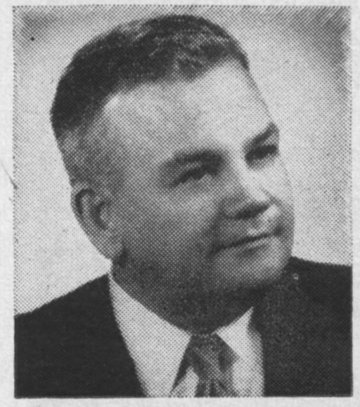
As well-known as he was among those who grew up reading his
articles, little has ever been written about John T. Frye himself.
Setting this right has taken more time and more work than I had
expected, and I want to thank several people for digging around
and locating what data there is, especially Michael Holley and Bob
Ballantine W8SU.
US Census records tell us that John Frye was born in Poinsett
County, Arkansas on March 14, 1910. He was the second son of Orton
P. and Essie Frye. His older brother Parker was born in 1905.
Orton Frye was listed as owner of a sawmill in 1910, and in 1920
owned a machine shop in West Prairie, Arkansas, with his son
Parker working there with him. The 1930 census shows the Frye
family as moved to Logansport, Indiana, and living at 1810
Spear St., the house where John lived, as best we know, for
the rest of his life. (The 1940 census records are still sealed,
and will not be released until 2012.) Orton P. Frye is not shown
in the Social Security Death Index, and it may be that he died
before the Social Security system was put in place in the late
1930s. Essie lived to be 91, and died in 1974. Parker A. Frye died
in 1971 in Park Ridge, Illinois, where he had lived for some time.
No evidence has ever come to light indicating that Frye married or
had children.
Quite a few Fryes lived in west-central Indiana, and some even in
Logansport. This has caused some confusion: There was another John
T. Frye living in Camden, Indiana, from 1932-1976, and Camden is
only fifteen miles from Logansport. This other John T. Frye
married in 1955 and had two sons. Several people wrote to tell me
that John Frye had a brother, Samuel Bailey Frye, in Logansport,
as well as a sister Eunice. Bailey was a ham (WA9OWH) and died
only recently (2008) at age 90. However, Bailey's
obituary does not mention John T. Frye, nor do the census records
include Bailey in John Frye's family, so we can only assume he was
unrelated, or perhaps a cousin. (Ditto Eunice.)
Amazingly, he spent virtually all of his life in a
wheelchair due to a battle with polio when he was eighteen months
old,
and was never able to walk. The disease also affected his left
hand,
which he could use only imprecisely, and with difficulty. His
father
(who was a machinist) built a very maneauverable three-wheeled
scooter
out of a girl's tricycle, and John used that to get around his
small
and presumably crowded house for many years—the photo below shows
John
in the scooter when he was 66. He had several cars fitted out with
hand
controls and did a great deal of traveling around the United
States. We
know that he had a 1963 Olds Dynamic 88; legend holds that he
favored
Buicks, but we do not have confirming data at this time.
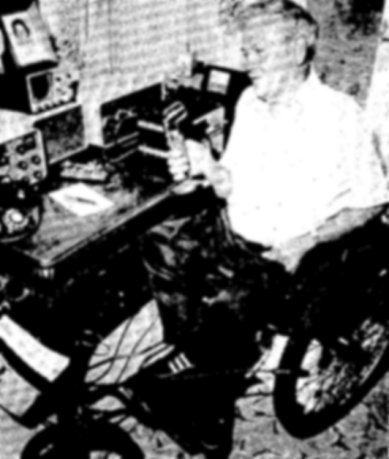
(The photo is a screen capture of a microfiche scan
of a 1976 newspaper halftone, so alas, only so much can be done
with it!)
Frye was licensed as W9EGV in the 1920s, and graduated from
Logansport High School in 1930. Most people have assumed that he
attended Purdue University because of Carl & Jerry's college
career at fictional Parvoo, which shares details with Purdue in
only the thinnest disguises (like the Moss-Ade Stadium instead of
Purdue's Ross-Ade Stadium) and sometimes, as with the
Purdue/Parvoo radio station WCCR, no disguise at all. But as best
we know, he never attended Purdue, and in fact did not study
engineering at all. He did attend Indiana University, Columbia,
and the University of Chicago at one point or another, studying
psychology, journalism, history, and English. We do not know
whether or where he obtained a degree.
Studying journalism and English clearly paid off. Frye was a very
prolific contributor to the electronics and amateur radio
magazines, with supposedly 600 short pieces to his credit. The
earliest published works I've seen in the literature are a series
of short humorous items (titled "Phone Band Funnies") in QST
beginning August, 1947. However, he supposedly first appeared in
Gernsback's seminal Short Wave Craft (ancestor of Radio-Electronics)
in the early 1930s. (The
magazine's covers are classics.) He began writing a column
called “Mac’s Service Shop” in Radio & Television News
in April 1948, and it ran in one magazine or another (including Electronics
World, another Ziff-Davis publication) for 28 years, until
June, 1977. There are superficial resemblances between "Mac's
Service Shop" and Carl and Jerry: The column is nominally fiction,
in which "Mac," the owner of a radio and TV service shop, talks
about both the technical and business aspects of the radio/TV
service business to other people, often his sole and slightly
clueless employee, Barney. However, there is no "adventure" and
the action doesn't typically move beyond the shop. For a sample of
"Mac's Service Shop" in its later years, you can see scans of the
August 1975 column hosted here.
In addition to his short articles, John Frye wrote a couple of
very popular books on radio and servicing:
- Basic Radio Course (Gernsback Library #44) first
published in 1951, revised in 1955 and 1962, and reprinted by
Tab at least as late as 1977.
- Radio Receiver Servicing, 1960.
Copies of these come up on Amazon and ABEBooks regularly, and if
you collect or restore old radios they are well worth having. They
are not especially rare, and I paid about $10 each for nice clean
hardcovers. Basic Radio Course is a excellent overview of
AM radio tech circa 1950, well-written, and printed on a coated
paper that has survived well without yellowing or getting crumbly.
The 1962 edition adds some limited coverage of solid state theory.
Interestingly, my research has not shown a copyright renewal for
either Basic Radio Course or Radio Receiver Servicing,
and so their copyrights have probably expired and both have now
passed into the public domain.
From his writing it's clear that Frye knew the radios and TVs of
his era inside and out, but I've been unable to determine where he
learned the service trade, nor whether he worked in the service
field. We have no evidence that he owned his own service shop, but
from his nearly thirty years of Mac's columns it sure sounds
like he did!
A good many of the details we know about Frye's life are
summarized in a short 1962 article
in the Logansport newspaper announcing the release of an updated
edition of Basic Radio Course. (The photo was actually
taken in 1951, and appears in another short article announcing the
release of the book's first edition in that year.) Many thanks to
Lisa Enfinger for passing a scan of this along to me. Doesn't Frye
look a lot like a grown-up Jerry in the photo?
Lisa also provided a clue as to why Frye patterned Parvoo
University on Purdue: Her parents were very close friends of
Frye's, and both studied chemistry at Purdue in Frye's era. Frye
maintained a lively correspondence with both William and Margie
McCaughey for many years, and probably visited them while they
earned their degrees at Purdue in the late 1940s. Even after her
parents moved to Tucson to teach at the University of Arizona, her
mother (and Lisa too) would return to Logansport in the summers to
visit, and then spent a fair amount of time with John, who would
take young Lisa to the park on the Eel River in Logansport and buy
her rides on their merry-go-round. Lisa's great-grandparents lived
right across the street from Frye, on Spear Street in Logansport.
Her father,
Dr. William. F. "Mac" McCaughey, K7CET, may have been the
namesake of the narrator of Mac's Service Shop. Lisa's mother's
uncle, Eugene Buntain, was a classmate of Frye's at Logansport
High School. The two discovered electronics and ham radio at the
school and were close friends; Lisa wonders if Uncle Gene were the
inspiration for Carl.
Why did Frye stop writing "Carl & Jerry"? A couple of
old-timers have hinted that he had had a falling-out with the
editors at Popular Electronics toward the end of 1964.
This is suggested by the fact that he began publishing a lot of
articles in PE's main competitor, Electronics Illustrated,
early in 1965. I do not have all issues of EI from that era, but
Frye appeared in the July 1964 issue with "A Basic Course in
Vacuum Tubes." From 1965 into late 1967 he was in most issues of
EI with a couple of multipart tutorials: "The ABCs of Radio"
beginning in September 1965, and "The ABCs of Color TV" beginning
in January 1967. The last issue I have in which Frye appears is
September, 1967—which is also when my subscription to EI expired.
I have a handful of issues from 1968, and Frye does not appear in
any of them, nor does he appear in any issues of Popular
Electronics after that. "Mac's Service Shop" ran until 1977,
but Frye's other writing seems to have ceased ten years earlier.
John T. Frye died in January, 1985, at his home in Logansport.
As always, I'd love to hear from you if you have additional
details about John T. Frye's life and work beyond what I've posted
here.


Back in 2006, I tried to locate a few of my favorite
Carl and Jerry adventures, and discovered that old back issues of
Popular Electronics are not easy to come by, and not always
cheap. Being a technical book publisher in my day job, I had the
notion that an anthology of Carl and Jerry stories would be a good
thing to put together, before the old magazines either crumbled to
dust or ended up in landfills as their owners passed on. After
all, the first Carl and Jerry story—in the very first issue of Popular
Electronics—is now over half a century old. Time flies when
you're down in the basement building things, sheesh.
So I located the owner of the Carl and Jerry
copyrights, and obtained permission to republish them in anthology
form. As I cornered an ever-larger pile of the magazines on eBay,
I realized that a single book would not do it. There are 119
stories in all, representing close to 250,000 words and 300
illustrations. The five anthologies together will include every
Carl and Jerry story by John T. Frye, including all the original
illustrations. The stories will be published in chronological
order, by issue date. In general, there are two years' worth of
stories in each volume. The final volume contains a "topic index"
to all 119 stories, plus two brand new stories by long-time Carl
and Jerry fans.
All five books are now available, and may be ordered
from Lulu.com. Click on the book volume links below to order.
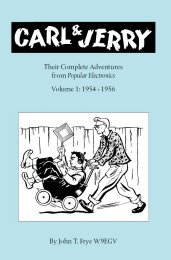 Available
now: Available
now:
Volume 1:
1954-1956
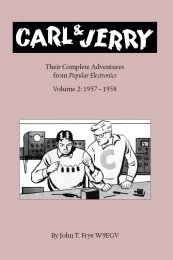 Available
now: Available
now:
Volume 2: 1957-1958
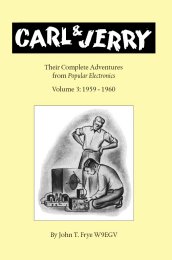 Available
now: Available
now:
Volume 3: 1959-1960
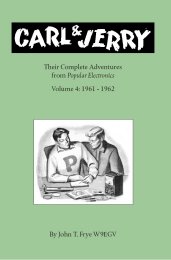 Available
now: Available
now:
Volume 4: 1961-1962
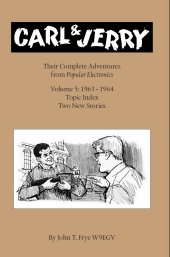 Available now: Available now:
Volume 5: 1963-1964
Note: The anthologies are printed and sold one at a
time by print-on-demand technology, and thus will not be available
from bookstores. Alas, this means that you can't order them
"overnight" as the Lulu system takes between 3 and 5 days to
manufacture each book before the book is shipped.

|
